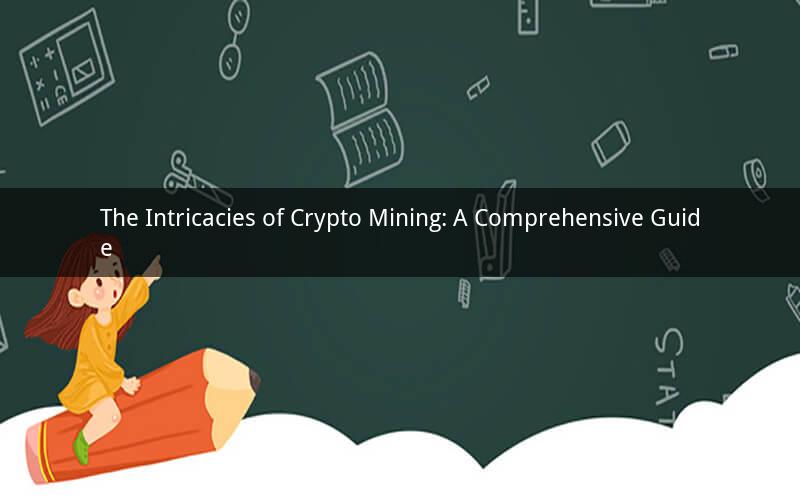
Introduction:
Crypto mining, an essential component of the blockchain ecosystem, has gained immense popularity over the years. With the rise of cryptocurrencies like Bitcoin, Ethereum, and Litecoin, the demand for crypto mining has surged. This guide delves into the world of crypto mining, explaining its concept, importance, and the tools and techniques involved. Let's explore what crypto mining is all about.
What is Crypto Mining?
Crypto mining is the process of validating and adding new transactions to a blockchain. Miners, equipped with powerful computers, use their computing power to solve complex mathematical problems. When a problem is solved, a new block is added to the blockchain, and the miner is rewarded with cryptocurrencies.
The Importance of Crypto Mining:
1. Security: One of the primary reasons for crypto mining is to ensure the security of the blockchain. By requiring significant computing power to add new blocks, crypto mining makes it extremely difficult for hackers to manipulate the network.
2. Decentralization: Crypto mining helps in decentralizing the blockchain network. As more miners participate in the process, the network becomes more robust and less susceptible to manipulation by a single entity.
3. Transaction Verification: Crypto mining ensures that all transactions are verified and added to the blockchain in a chronological order. This helps maintain the integrity of the network and prevents double-spending.
4. Incentivization: Miners are rewarded with cryptocurrencies for their efforts. This incentivizes individuals to participate in the process, ensuring the continued growth and development of the blockchain network.
Tools and Techniques for Crypto Mining:
1. Hardware: The most crucial tool for crypto mining is the mining hardware. Different cryptocurrencies require different types of hardware. For instance, Bitcoin mining requires powerful ASIC (Application-Specific Integrated Circuit) miners, while Ethereum mining can be done using GPUs (Graphics Processing Units).
2. Software: Mining software is essential for connecting your hardware to the blockchain network and managing the mining process. It allows miners to monitor their performance and receive notifications when a block is solved.
3. Mining Pools: Mining pools are groups of miners who work together to increase their chances of solving a block. When a block is solved, the rewards are distributed among the members based on their contribution.
4. Cooling Systems: As crypto mining involves high-performance hardware, it generates a significant amount of heat. Effective cooling systems are essential to prevent hardware damage and ensure smooth operation.
5. Electricity: Mining requires a considerable amount of electricity. Miners must ensure that their electricity costs are minimized to maintain profitability.
Common Crypto Mining Challenges:
1. High Costs: The cost of mining equipment, electricity, and cooling systems can be substantial. This can be a significant barrier for new miners.
2. Competition: As the number of miners increases, the difficulty of solving mathematical problems also rises. This makes it harder for new entrants to compete.
3. Market Volatility: The value of cryptocurrencies can fluctuate dramatically, impacting the profitability of mining operations.
4. Legal and Regulatory Issues: Some countries have imposed restrictions on crypto mining, making it illegal or limiting its scale.
Frequently Asked Questions (FAQs):
Q1: What is the most profitable cryptocurrency to mine?
A1: The profitability of mining depends on various factors, including the cost of electricity, hardware, and the current market value of the cryptocurrency. As of now, Ethereum and Litecoin are considered to be the most profitable cryptocurrencies to mine.
Q2: Can I mine cryptocurrencies using my regular computer?
A2: While it is possible to mine cryptocurrencies using a regular computer, it is not very efficient. The high computational power required for mining makes it more practical to use specialized mining hardware.
Q3: What is the best mining hardware for Ethereum?
A3: GPUs (Graphics Processing Units) are the most suitable mining hardware for Ethereum. NVIDIA's GeForce RTX 3080 and AMD's Radeon RX 6800 XT are among the best options for Ethereum mining.
Q4: How do I choose the right mining pool?
A4: When selecting a mining pool, consider factors like pool size, fees, and location. Larger pools offer better rewards but have higher fees. Ensure that the pool's location aligns with your electricity costs to maximize profitability.
Q5: Can crypto mining be considered as a sustainable business?
A5: The sustainability of crypto mining depends on the efficiency of the mining operation and the cost of electricity. As long as miners can operate profitably while minimizing their environmental impact, crypto mining can be considered a sustainable business.
Conclusion:
Crypto mining plays a vital role in the blockchain ecosystem by ensuring security, decentralization, and transaction verification. Understanding the concept, tools, and challenges of crypto mining can help individuals make informed decisions and participate in this dynamic field.